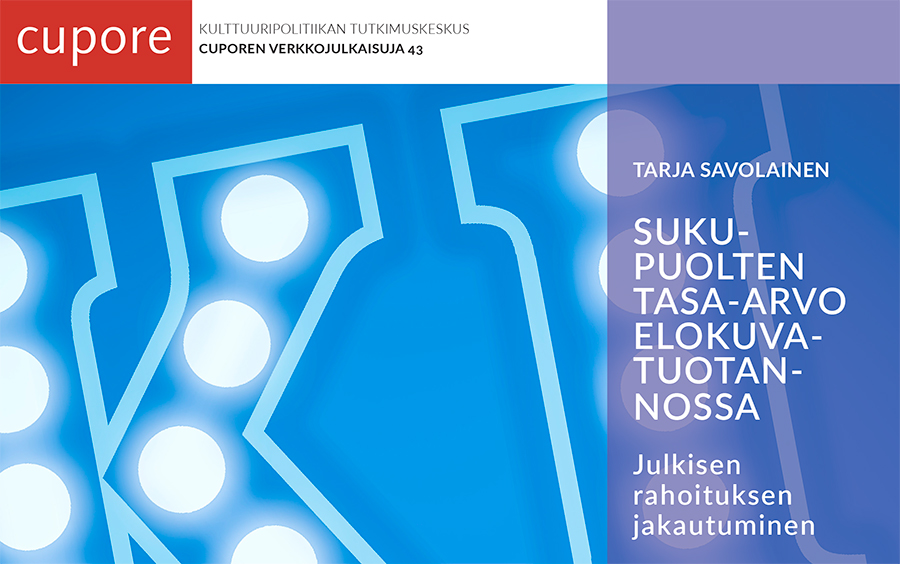Only about one-fifth of Finnish feature-length fiction films are directed by women. The situation has not changed since the mid 1990’s. One reason presented for this consistent imbalance lays in women filmmakers´ difficulties receiving funding for their films.
The purpose of the report was to find out whether gender equality was realised in the public financing of Finnish film. In addition, factors that may cause gender inequalities in film production more broadly were evaluated.
The statistics created in the study were based on information from five organisations: the Finnish Film Foundation (2011—2015), the Nordic Film and Television Fund (NFTF) (2012—2015), the Promotion Centre for Audiovisual Culture (AVEK) (2011—2015), the Finnish Broadcasting Company (YLE) (2011—2015), and Arts Promotion Centre Finland (Taike) (2013—2015). The organisations gave us data on their financing decisions. Taike provided us with existing statistical tables. In addition, eight female filmmakers and eight film commissioners were interviewed.
Gender equality was approached as a question of financial resources: do women and men receive an equal amount of public financial resources for their films? Public resources referred to funds originating from the state budget. Some of the organisations also get funding to a small degree from other sources.
These organisations finance film production by granting support for films and TV series and/or by giving grants to individual film artists. The Finnish Broadcasting Company YLE buys and commissions films and TV series.
The Finnish Film Foundation is the main supporter of Finnish film. It is a private foundation which operates under the guidance of the Ministry of Education and Culture. The Ministry grants the Foundation its yearly support and operational funds from lottery and pools funds allocated for the promotion of cinema in the state budget. The other main financier is the Finnish Broadcasting Company YLE, which commissions audiovisual productions from independent production companies and finances films. The other organisations of the study had clearly fewer resources for financing films.
About 150 million euros were analysed in the research. The share of the Finnish Film Foundation was about 93 million euros of this sum, while YLE’s share was about 46 million euros. The total share of the other three organisations was about 11 million euros.
Women film artists and films directed by women got about one fourth (24 %) of the amount. Respectively, films directed by men and male film artists received three fourth (74 %) of the total. Thus, women clearly received less public financial resources for filmmaking than men. In this sense, gender equality was not realised. When the women’s share of public film financing was proportioned to the share of women among film artists (43%) and to the number of women educated in film (estimated to represent about one half), the situation was still very imbalanced.
The financing granted by the Finnish Film Foundation was compared to the share of the applications and to the share of positive financing decisions on two forms of support: scriptwriting grants and production support.
The analysis showed that women and men got grants for scriptwriting in the same proportion compared to their share of the applications. However, the grants for women were on average a little smaller than the grants for men.
Films directed by men got clearly more film production support from the Finnish Film Foundation. The analysis showed that the share of films directed by women in the production support euros (including so-called 50/50 production support) was lower (24.6 %) than their share of the applications (29 %) and of the positive support decisions (32 %). However, feature-length fiction films directed by women received on average more production support per film than films directed by men, if the 50/50 support was excluded. At the time of the research, a special film financing experiment was underway at the Finnish Film Institute, which probably explains the result. The films directed by women were middle-range budget films. Earlier analyses by the Finnish Film Institute have indicated that films directed by women have received production support in the same proportion compared to their share of the applications.
The Finnish Broadcasting Company YLE financed films and TV drama series with about 46 million euros in 2011–2015. Films and TV series directed by men received 79 % of the total amount, while films directed by women received 18 %. All the productions that YLE had commissioned from independent companies were directed by men. However, there were both female and male scriptwriters and producers in these TV series.
The Promotion Centre for Audiovisual Culture funded short films, documentaries and animation films with about 4 million euros in the analysed period. The funding was divided rather equally among the genders.
The Nordic Film and Television Fund granted about 4.5 million euros to Finnish films and television series in 2012–2015. Films directed by men got 82 % of the sum. Films directed by Finnish women directors received funding in the same proportion compared to their share of the Finnish films.
Arts Promotion Centre Finland awarded about 2.4 million euros to film artists as grants in 2013—2015. 62 % of the sum went to men. The share of women was about the same as their overall proportion among film artists in Finland.
The study also indicated that the financing organisations do not report how the money is awarded per gender.
It was proposed that the valuing of film protagonists and stories according to gender might be one central factor that creates divisions and inequality in film production.
One of the main suggestions was to create a database that would enable the monitoring of public film financing and the evaluation of gender equality. In the forthcoming research, the careers of film directors should be analysed in more detail.
DOWNLOAD (Finnish)
Original source: Cupore
